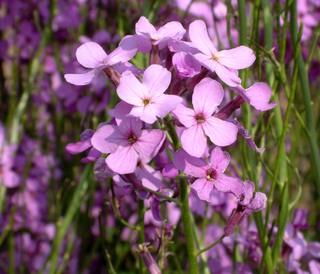
The American crow is a large passerine bird species of the family Corvidae. It is a common bird found throughout much of North America. American crows are the New World counterpart to the carrion crow and the hooded crow of Eurasia; they all occupy the same ecological niche. Although the American crow and the hooded crow are very similar in size, structure and behavior, their calls and visual appearance are different.

Chimaeras are cartilaginous fish in the order Chimaeriformes, known informally as ghost sharks, rat fish, spookfish, or rabbit fish; the last three names are not to be confused with rattails, Opisthoproctidae, or Siganidae, respectively.

Hesperis matronalis is an herbaceous flowering plant species in the family Brassicaceae. It has numerous common names, including dame's rocket, damask-violet, dame's-violet, dames-wort, dame's gilliflower, night-scented gilliflower, queen's gilliflower, rogue's gilliflower, summer lilac, sweet rocket, mother-of-the-evening, Good & Plenties, and winter gilliflower.

Hesperis is a genus of flowering plants in the family Brassicaceae. Most are native to Eurasia, with several endemic to Greece and Turkey. Many plants of this genus bear showy, fragrant flowers in shades of purple and white. One of the more widely known species is the common garden flower Hesperis matronalis. The genus name Hesperis was probably given because the scent of the flowers becomes more conspicuous towards evening.

A fish is an aquatic, craniate, gill-bearing animal that lacks limbs with digits. Included in this definition are the living hagfish, lampreys, and cartilaginous and bony fish as well as various extinct related groups. Approximately 95% of living fish species are ray-finned fish, belonging to the class Actinopterygii, with around 99% of those being teleosts.
Edaphodon was a fish genus of the family Callorhinchidae. As a member of the Chimaeriformes, Edaphodon was a type of rabbitfish, a cartilaginous fish related to sharks and rays. The genus appeared in the Aptian age of the Lower Cretaceous and vanished in the Pliocene. It was most prominent during the Late Cretaceous. Many Edaphodon species were found in the Northern Hemisphere, but species from the Southern Hemisphere are also known.
Edaphodon kawai was a prehistoric chimaeriform fish species belonging to the genus Edaphodon, of which all the species are now extinct. Edaphodon kawai was a type of rabbitfish, a cartilaginous fish related to sharks and rays, and indeed, some rabbitfishes are still alive today. E. kawai is one of numerous Edaphodon species, but is the only one which has been discovered in the Southern Hemisphere, near New Zealand. Indeed, only a handful of other Chimaeroformes have been discovered in the Southern Hemisphere. They first appeared during the Devonian period around 415 to 360 million years ago, but the only known specimen of E. kawai has been dated to the Late Cretaceous at the height of the rabbitfish's reign. Its scientific name, kawai, means "fish" in the language of the Moriori, a Pacific tribe who inhabited the islands.

Callicore is a genus of nymphalid butterfly found in the Neotropical realm. This genus, like some related ones, was formerly lumped together as the paraphyletic Catagramma assemblage.

Duriavenator is a genus of theropod dinosaur that lived in what is now England during the Middle Jurassic, about 168 million years ago. In 1882, upper and lower jaw bones of a dinosaur were collected near Sherborne in Dorset, and Richard Owen considered the fossils to belong to the species Megalosaurus bucklandii, the first named non-bird dinosaur. By 1964, the specimen was recognised as belonging to a different species, and in 1974 it was described as a new species of Megalosaurus, M. hesperis; the specific name means 'the West' or 'western'. Later researchers questioned whether the species belonged to Megalosaurus, in which many fragmentary theropods from around the world had historically been placed. After examining the taxonomic issues surrounding Megalosaurus, Roger B. J. Benson moved M. hesperis to its own genus in 2008, Duriavenator; this name means "Dorset hunter".
Nicotiana occidentalis subsp. hesperis is a short-lived herb native to Australia.
Abu Muqri Mohammed ibn Ali al-Battiwi was a Moroccan astronomer who wrote a poem on the calendar, astronomy and the determination of the hours of Moslem prayer. According to the German orientalist Carl Brockelmann, al-Battiwi was the commanding general of the Marinid sultan of Morocco, Abu al-Hasan Ali ibn Othman.
Desmatodon is an extinct genus of diadectid reptiliomorph. With fossils found from the Kasimovian (Missourian) stage of the Late Carboniferous of Pennsylvania, Colorado, and New Mexico in the United States, Desmatodon is the oldest known diadectid. Two species are currently recognized: the type species D. hollandi and the species D. hesperis.

Argynnis is a genus of butterflies in the family Nymphalidae, one of several groups known as "fritillaries".

Callicore hesperis, the hesperis eighty-eight or hesperis numberwing, is a species of butterfly of the family Nymphalidae. It is found in Colombia, Brazil, Ecuador, Peru, and Bolivia.
The New Egypt Formation is a Late Cretaceous (Maastrichtian) geologic formation of the Monmouth Group in New Jersey, United States.
Edaphodon mirificus is a species of Edaphodon, which was found by Joseph Leidy in 1856, in Hornerstown, New Jersey.

Dineobellator is a genus of dromaeosaurid theropod dinosaur that lived in North America during the Late Cretaceous period 68 million years ago. The remains have been found in the Maastrichtian stage of the Naashoibito Member at the Ojo Alamo Formation, New Mexico.
Hesperis kotschyi, commonly called Kotschy's damask flower, is a flowering plant in the family Brassicaceae. It is named after the 19th century Austrian botanist Theodor Kotschy. The species is endemic to southern Turkey in the Irano-Turanian floristic region. Hesperis kotschyi is a perennial herb which has lilac colored flowers. Its habitat is among rubble on plateaus at elevations of 1,800–2,300 m (5,900–7,500 ft).









